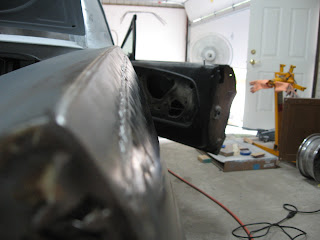It's been about 4 months since my last post. However my absence on here is by far no indication of actual progress on the car as I've had the transmission rebuilt, reinstalled with motor, undercarriage cleaned and touched up, drive shaft restored, and slowly getting the motor externals hooked up. I all but was forced to give up on body work in September as I was running out of warm enough days. I don't like to block if I can't shoot epoxy soon after. It is annoying and aggravating when a sand-through spot to metal flash rusts if I don't epoxy soon enough. And truth be told I'm utterly sick of bodywork.
First off, here's how that quarter skin ended up after the Slick Sand application. The picture I don't have included is after it was blocked. To my surprise it was incredibly straight and there were very few low spots.
 |
| And this was the current status of the car with a panel mock up. I took the fenders and hood back off so I can do other work. |
Seam Sealer
First thing's first, and before you do any seam sealer work, read
this. I employed these techniques for this round of seam sealing, though I did not on previous rounds and am left wishing I did. Going back to some of the very earliest postings in this blog, I described sealing seams with 3M Fast n Firm (they really need a better name for that), and 3M Brushable seam sealer. I'm here today to tell you they are garbage now, and that sealer is now cracking.
The way to go is with a quality non-hardening (it hardens but not to the point it's like brittle concrete) 2k seam sealer for lasting seams. There are a number of reputable brands making good 2k material such as SEM, 3M, PlioGrip, and others which escape me. After doing my research I ended up with Valvoline's PlioGrip as it is OE material for cars made today. The downsides is the expense. The cartridges are expensive in themselves, but you also have to buy a specific applicator gun for the brand of sealer you are buying. And the guns are not cheap...mine was around $60-70 if I remember right. PlioGrip makes 3M's gun, only the PlioGrip gun is cheaper than the identical 3M gun. So if you buy the less expensive PlioGrip gun you can not only use PlioGrip seam sealers in it but the entire line of 3M 2k sealers as well. All in all, walking out of the store with my gun, 2 cartridges of seam sealer, and a bag of extra tips, I was looking at $120.
 |
| I went with the #6 non-sag sealer to do everything, including gutters. It sets up relatively fast...you have around 3-6 minutes to work it before it starts to set up. The glorious thing about it is it has no VOC's and is virtually odor-free. I did not need to wear a respirator to apply this, but the 3M sealers I was adding several years ago about knock you out if you didn't have a respirator. |
|
|
|
I have the factory body and seam sealer assembly manual so I could see where all the seam sealer went, how it was to be applied, and what type of sealer was being used. The easiest way to summarize is basically ANY seam created by one panel of metal joined to another panel is sealed on the entire car. This includes where the tail light panel comes together with the quarter on the outside rear as well as the insides in the trunk. Don't forget under the drip rails of the windows either. I add sealer and then smooth with my finger.
 |
| I'm using the double-masking method Brian describes in his article I linked above. Here is the door when sealing the seam of the skin and door shell. |
 |
| Sealing passenger side door jamb. The thin channel in between the tape is where the seam being sealed is located. |
 |
| It takes some time and tape in preparation, but masking off both sides of the seam ultimately makes the process of adding and smoothing the sealer go faster because you don't have to be neat about it. And once the tape is removed it leaves a very clean edge. I removed the tape just as it was starting to set up, otherwise there was a tendency for the edge of the sealer to pull up a bit. |


























































